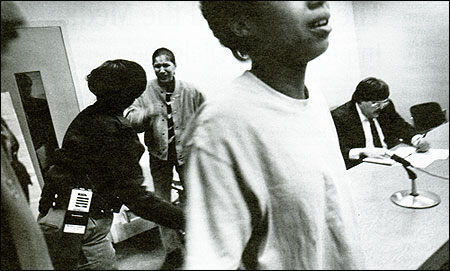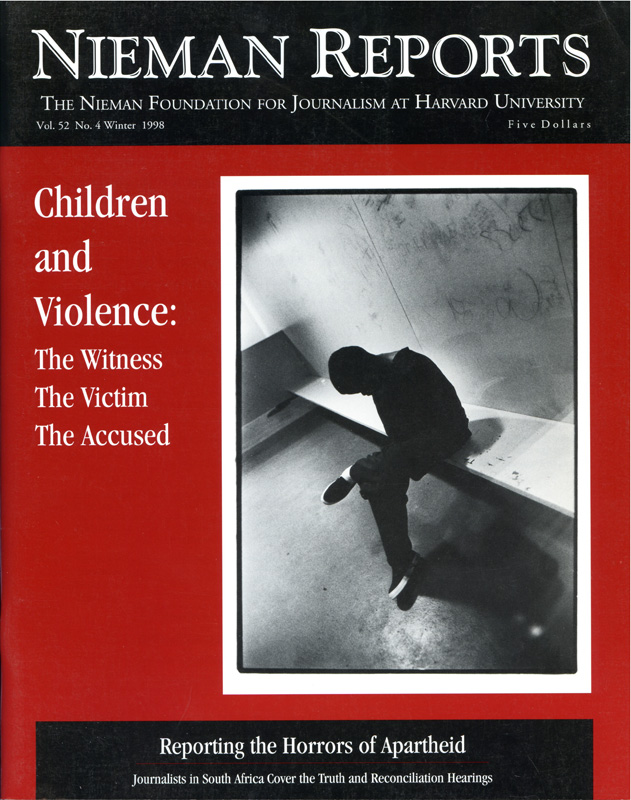
Youngster at Wayne County Juvenile Justice Center in Detroit. Photo by Pauline Lubens/The Detroit Free Press.
In ancient times, a coin was flipped to assist people in important decisions of life. It was believed the gods would assure that the correct side would land upright.
Like the two sides of a coin, the people who work in the proceedings of the Juvenile Court system and reporters seem like they should be joined together yet, for a variety of reasons, too often they become antagonists. Each side seems incapable of understanding the other’s point of view, and these differing perspectives create the feelings of annoyance that seems to thrive between them. There is an inherent lack of trust and increasing lack of respect for the work each tries to do.
Unfortunately, today, people don’t believe that the gods can intervene and bring about some resolution. Instead, finding common ground is an enterprise these two parties must enter into together and one in which they must establish rules and create relationships that will build trust.
So far, however, one of the most divisive issues—whether the Juvenile Court should be open to the media—has resulted in more heated argument than clear-headed debate and analysis. Traditionally, Juvenile Courts were closed to the public, including the press. The original concept for this exclusion was a valid one and retains some validity today.
The traditional role of the Juvenile Court is the protection of the public through rehabilitation of the delinquent child. As some sports stars remind us, “Image is everything.” If a child’s reputation is wrapped in the tight swaddling cloth of “delinquent,” he has a nasty habit of living up to such expectation. If that child is to have the chance to be rehabilitated, then granting him the opportunity to not be burdened with that stigmatizing label and damaging publicity becomes imperative.
But as with the coin toss, there are flip sides to this perspective. Should every child—regardless of the severity of their crime or the frequency of their criminal behavior—be given an open-ended opportunity to rehabilitate? Does the public have a right to be informed of what is being done to serve that purpose of rehabilitation? And doesn’t the public have the right to be informed of what occurs in a publicly funded court? And if it does, are there ways in which the privacy of youngsters’ lives—especially those for whom we hold out the hope of a rehabilitated future—can be protected?
When I became Presiding Juvenile Court Judge, one of my first actions was to open the court to both the media and the public. I am told that I was the first judge to open the Juvenile Court in Arizona to the broadcast and print media. After eight years, I continue to believe my decision was the right one and benefits everyone. I recognize that mine remains a controversial position and that others in my profession disagree. While I hope we can disagree without being disagreeable, what I’ve learned during these eight years might provide valuable guidance both to reporters who want to do their job from inside the courtroom and to judges who hold the keys.
First, maintain open communications. Both the court and the media place a premium on good communication skills. Good communication is hard work; for it to be successful, it must be clear and honest, and its speakers must be willing to expose their vulnerabilities. The deeper the level of communication, the harder the work.
Any candid assessment of the court and media would declare there is virtually no beneficial communication between the two. The ancient fires of disharmony between them seem to rage too hot and too high. It is a simple adage but true, “Old habits die hard.” This less than cordial relationship appears to be based more on a habit of practice than meaningful discussion. Any meaningful effort to initiate productive lines of communication must include recognition of a need of at least two things: Thought and time.
One thing that is true about both judges and reporters is that they are rarely undecided. Yet what makes them similar is frequently glossed over or ignored. Judges make decisions. While reporters might view some of their decisions to be in error, they are rarely undecided. Reporters make decisions in the ways they report on stories. While their “slant” on a story may be wrong from my viewpoint, their stories rarely read as though the newspaper is undecided about its viewpoint. It is essential that each of us understand the other’s leanings. This can be accomplished by investing time and thought in communicating with each other candidly about even trivial things. If that’s done with the little things, then lines of communication will be open when weightier topics come along. Trust builds through communication and communication builds trust.
Secondly, seek to understand and be understood. Relationships begin and end with understanding and seeking to be understood. Judges usually do not have a full appreciation for the pressure of a deadline that a reporter faces. What happens in a community can send a reporter on a fast-breaking sprint to the front page; if roadblocks are placed in the way, valuable information can become yesterday’s news.
Similarly, reporters frequently do not have a clear sense about the basics of the justice system, let alone the key differences between juvenile and adult criminal court. Nor do they understand the original purpose of creating a separate system predicated on “rehabilitating” the offender. I learned this from an unfortunate front-page story.
A teenager was charged with the assault and attempted rape of a senior citizen. The state filed a request that the juvenile be tried as an adult. As a result of the passage of Automatic Transfer laws in Arizona, such a teenager would be tried as an adult today since he was over the age of 13, and the charge against him was “severe.” On the day of the hearing the prosecutor admitted that the state had substantial problems with the case. Each of its three witnesses would testify this juvenile was not the one they had seen at the scene of the crime. There was no evidence that conclusively identified the assailant. There had been one piece of physical evidence; the sheriff had made a plaster mold of the assailant’s footprints. However, an officer had broken the mold and thrown it away.
To add to this farce, another officer had returned the shoes that might have provided conclusive evidence and, by now, those shoes had been thrown away. To add to the chaos, the police report provided the footprints’ measurements and, due to the large size of the defendant’s feet, it was impossible that the teenager could have made the prints.
Given the weakness of the State’s case, the prosecutor made an offer of guaranteed continued probation. (The defendant was on probation for an incident that occurred while in detention on this assault charge.) Because this juvenile did not want to risk being transferred to adult court, he accepted the plea agreement and pled “No Contest,” against the advice of his attorney.
Later, when he was charged with the rape of some university students, this juvenile’s file, including information about this prior case, was given to the members of the print media upon request. All but one newspaper provided an accurate account based on this file. This one newspaper lambasted the prior release of this juvenile. The paper reported that he “had violently assaulted a senior citizen.” Their political cartoonist pictured me as a clown.
This story might have turned out differently if lines of communication had been opened. If that reporter had sought to learn more about what had occurred, and had established an open line of communication with me as other reporters had, I might have been able to help him to understand how the plea agreement related to the facts of the case. But there had been no line of communication set up through which I could work with him. As a result, his story turned out to be an inaccurate, and potentially harmful, portrayal.
Another important lesson I’ve learned is that both sides ought to learn how to not personalize this professional relationship. Instead they should try to learn about the demands of each other’s jobs and, in doing so, work to smooth over some of the rough edges that tend to emerge when tough cases receive coverage. This is not easy to do. Most Americans see themselves as tough individualists, as people who are able to “take a licking and keep on ticking.” It just isn’t so, especially when it carries a personal edge to it. Criticism stings. It can hit hard and leave you gasping for breath. But if criticism can be offered in constructive and accurate ways, remaining focused on job performance and not on personalities, relationships will work better.
Some of the youngsters who have come before me have reminded me of why my ability to see their lives in their entirety matters so much. One boy who was accused of vandalism had recently found his father in his bedroom, dead because of a self-inflicted shotgun blast. Nightmares and the dark stain of blood that remained on his wall drove this boy to leave his home and go in search of another place to sleep. At several of those places, he stole things. He was sentenced to probation, and while he was on it I wrote him letters. One day his mother told me how well her son was doing and described to me how he had covered that spot on his wall with my notes. All I could think about was how glad I was that his case had never been reported; had his name surfaced in terms of these incidents of vandalism, the publicity might have devastated him and altered forever his ability to find new ways of coping within his small community.
The media survive only as long as the public trusts what they say. Inaccurate storytelling or overly subjective reporting of what should be the presentation of objective facts can foster distrust. Once distrust settles in, the public responds, often by turning away from those who deliver the news.
Whether in issuing judgments or writing stories, each of us has a primary duty of serving the public interest. The poet Ella Wheeler Wilcox wrote:
“One ship drives east and another drives west
With the selfsame winds that blow
‘Tis the set of the sails
And not the gales
Which tells us the way to go.”
The different “set of the sails” guiding the journeys of courts and the media should make neither their relationship adversarial nor the product of their labors untrustworthy. They merely hold differing points of view, and these can and should be understood and respected by each. But the hard work involved in making this happen must take place if our two systems are going to bridge our differences and work in ways that benefit society, in general and these juveniles, in particular. Constructing these more effective relationships is too vital for us to accomplish to have either of us insulated within our own worlds and disengaged from building bridges to the other.
William J. O’Neil is Presiding Juvenile Judge for the Superior Court, hearing all juvenile matters in Pinal County, Arizona. The Governor of Arizona appointed him to his Juvenile Justice and Delinquency Prevention Council and the Children’s Justice Task Force. The Chief Justice of the Arizona’s Supreme Court named him to chair the Committee on Juvenile Courts.



